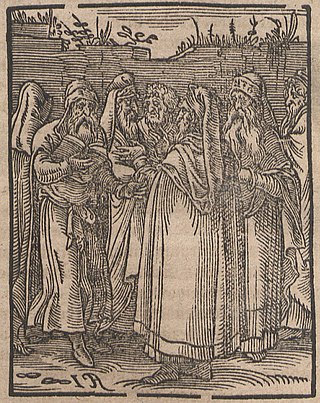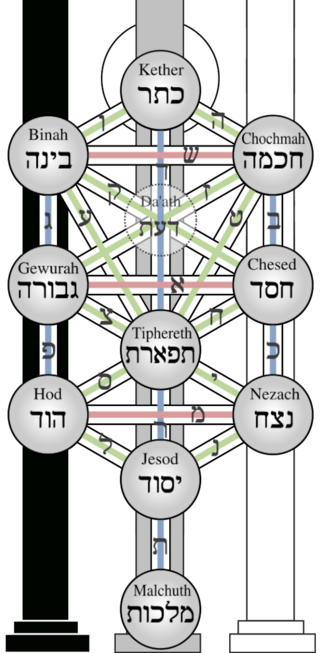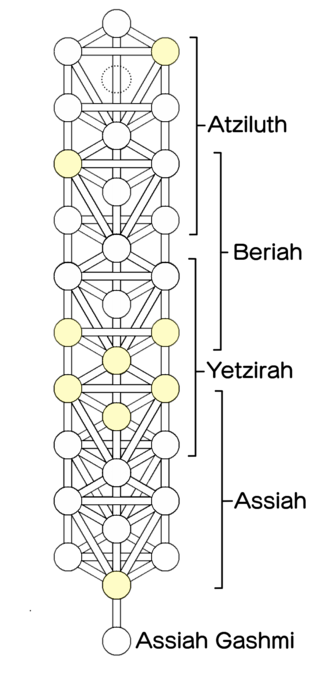
Kabbalah or Qabalah is an esoteric method, discipline and school of thought in Jewish mysticism. A traditional Kabbalist is called a Mekubbal. The definition of Kabbalah varies according to the tradition and aims of those following it, from its origin in medieval Judaism to its later adaptations in Western esotericism. Jewish Kabbalah is a set of esoteric teachings meant to explain the relationship between the unchanging, eternal God—the mysterious Ein Sof —and the mortal, finite universe. It forms the foundation of mystical religious interpretations within Judaism.

Abraham ibn Daud was a Spanish-Jewish astronomer, historian and philosopher; born in Córdoba, Spain about 1110; who was said to have died in Toledo, Spain, a martyr about 1180. He is sometimes known by the abbreviation Rabad I or Ravad I. His maternal grandfather was Isaac Albalia. Some scholars believe he was the Arabic-into-Latin translator known as Avendauth.
The doctrine or theory of immanence holds that the divine encompasses or is manifested in the material world. It is held by some philosophical and metaphysical theories of divine presence. Immanence is usually applied in monotheistic, pantheistic, pandeistic, or panentheistic faiths to suggest that the spiritual world permeates the mundane. It is often contrasted with theories of transcendence, in which the divine is seen to be outside the material world.

Sefirot, meaning emanations, are the 10 attributes/emanations in Kabbalah, through which Ein Sof reveals itself and continuously creates both the physical realm and the chain of higher metaphysical realms. The term is alternatively transliterated into English as sephirot/sephiroth, singular sefirah/sephirah, etc.

In the branch of Jewish mysticism known as Kabbalah, Daʻat or Da'ath is the location where all ten sefirot in the Tree of Life are united as one.
Azriel ibn Menahem ibn Ibrahim al-Tarās also known as Azriel of Gerona was the founder of speculative Kabbalah and the Gironian Kabbalist school. He is known for implementing Neoplatonic thought into mainstream kabbalistic tradition.
Ein Sof, or Eyn Sof, in Kabbalah, is understood as God prior to any self-manifestation in the production of any spiritual realm, probably derived from Solomon ibn Gabirol's term, "the Endless One". Ein Sof may be translated as "unending", "(there is) no end", or infinity. It was first used by Azriel, who, sharing the Neoplatonic belief that God can have no desire, thought, word, or action, emphasized by it the negation of any attribute. Of the Ein Sof, nothing ("Ein") can be grasped ("Sof"-limitation). It is the origin of the Ohr Ein Sof, the "Infinite Light" of paradoxical divine self-knowledge, nullified within the Ein Sof prior to creation. In Lurianic Kabbalah, the first act of creation, the Tzimtzum self "withdrawal" of God to create an "empty space", takes place from there. In Hasidic Judaism, the Tzimtzum is only the illusionary concealment of the Ohr Ein Sof, giving rise to monistic panentheism. Consequently, Hasidism focuses on the Atzmus divine essence, rooted higher within the Godhead than the Ein Sof, which is limited to infinitude, and reflected in the essence (etzem) of the Torah and the soul.

Chokhmah is the Biblical Hebrew word rendered as "wisdom" in English Bible versions.

The tree of life is a diagram used in Rabbinical Judaism in kabbalah and other mystical traditions derived from it. It is usually referred to as the "kabbalistic tree of life" to distinguish it from the tree of life that appears alongside the tree of the knowledge of good and evil in the Genesis creation narrative and well as the archetypal tree of life found in many cultures.
In Kabbalistic and Hasidic philosophy, seder hishtalshelut or hishtalshelus refers to the chain-like descent of spiritual worlds (Olam/Olamot) between God and Creation. Each spiritual world denotes a complete realm of existence, resulting from its general proximity or distance to divine revelation. Each realm is also a form of consciousness reflected in this world through the psychology of the soul.
Lurianic Kabbalah is a school of Kabbalah named after Isaac Luria (1534–1572), the Jewish rabbi who developed it. Lurianic Kabbalah gave a seminal new account of Kabbalistic thought that its followers synthesised with, and read into, the earlier Kabbalah of the Zohar that had disseminated in Medieval circles.

The Four Worlds, sometimes counted with a prior stage to make Five Worlds, are the comprehensive categories of spiritual realms in Kabbalah in the descending chain of Existence.

In Judaism, God has been conceived in a variety of ways. Traditionally, Judaism holds that what is Hashem, the god of Abraham, Isaac, and Jacob and the national god of the Israelites, delivered the Israelites from slavery in Egypt, and gave them the Law of Moses at Mount Sinai as described in the Torah. Jews traditionally believe in a monotheistic conception of God "Hashem is One" is characterized by both transcendence and immanence.
Ohr is a central Kabbalistic term in Jewish mysticism. The analogy of physical light is used as a way of describing metaphysical divine emanations. Shefa "flow" (שפע) and its derivative, hashpoah "influence" השפעה), are sometimes alternatively used in Kabbalah, a term also used in Medieval Jewish philosophy to mean divine influence, while the Kabbalists favour Ohr because its numerical value equals ר״ז, a homonym for רז rāz "mystery". It is one of the two main metaphors in Kabbalah for understanding God, along with the other metaphor of the human soul-body relationship for the sefirot.
Ayin is an important concept in Kabbalah and Hasidic philosophy. It is contrasted with the term Yesh. According to kabbalistic teachings, before the universe was created there was only Ayin, the first manifest Sephirah ,and second sephirah Chochmah (Wisdom), "comes into being out of Ayin." In this context, the sephirah Keter, the Divine will, is the intermediary between the Divine Infinity and Chochmah. Because Keter is a supreme revelation of the Ohr Ein Sof, transcending the manifest sephirot, it is sometimes excluded from them.
Atzmus or Atzmut is the descriptive term referred to in Kabbalah, and explored in Hasidic thought, for the divine essence.
Partzufim or Partsufim, meaning "Divine Personas", are particular reconfigured arrangements of the ten sefirot, divine attributes/emanations of Kabbalah. Each partzuf is thus a configuration of disparate entities into a harmonious unit. The names of the partzufim are derived from the Zohar, the foundational text of Kabbalah. There, they are synonymous terms for the sefirot. Their full doctrinal significance emerged in 16th century Lurianic Kabbalah with reference to the cosmic processes of Tohu and Tikun, "Chaos and Rectification".
Arich Anpin or Arikh Anpin (Aramaic: אריך אנפין meaning "Long Face/Extended Countenance" (also implying "The Infinitely Patient One", is an aspect of Divine emanation in Kabbalah, identified with the sephirah attribute of Keter, the Divine Will.
Olam HaTohu and Olam HaTikun are two general stages in Jewish Kabbalah in the order of descending spiritual worlds known as "the Four Worlds". In subsequent creation, they also represent two archetypal spiritual states of being and consciousness. Their concepts derive from the new scheme of Lurianic Kabbalah by Isaac Luria (1534–1572), the father of modern Kabbalah, based on his interpretation of classic references in the Zohar.
Kabbalah, the central system in Jewish mysticism, uses anthropomorphic mythic symbols to metaphorically describe manifestations of God in Judaism. Based on the verses "God created man in his own image, in the image of God created he him; male and female created he them" and "from my flesh shall I see God", Kabbalah uses the form of the human body to describe the structure of the human soul, and the nature of supernal Divine emanations. A particular concern of Kabbalah is sexual unity between male and female potencies in Divinity on high, depicted as interaction of the two sides in the sephirot, between archetypal partzufim, and the redemption of the exiled Shekhinah from captivity among the impure forces below.





